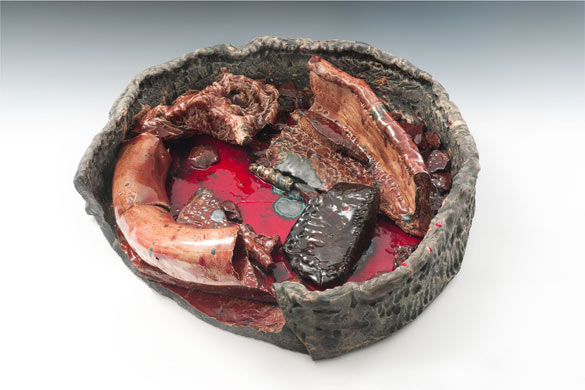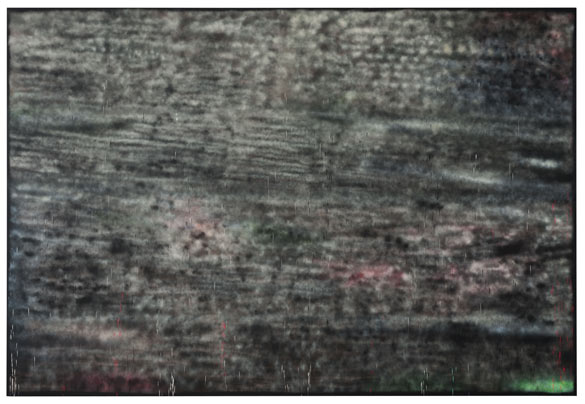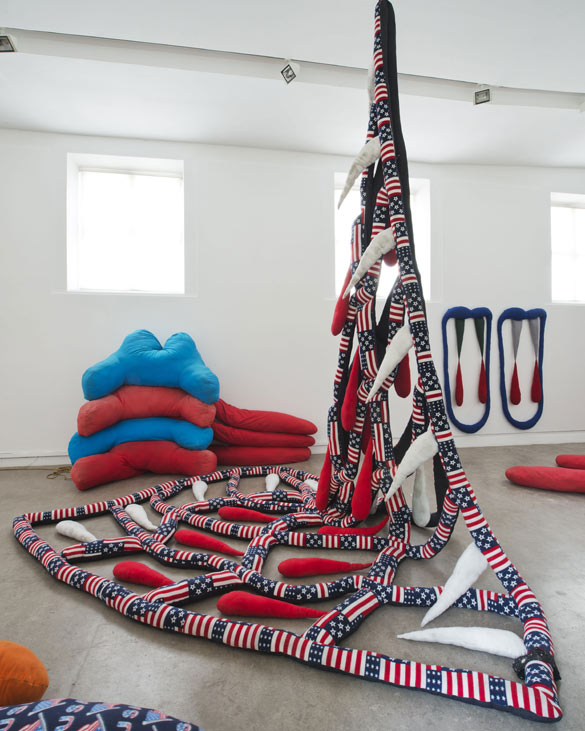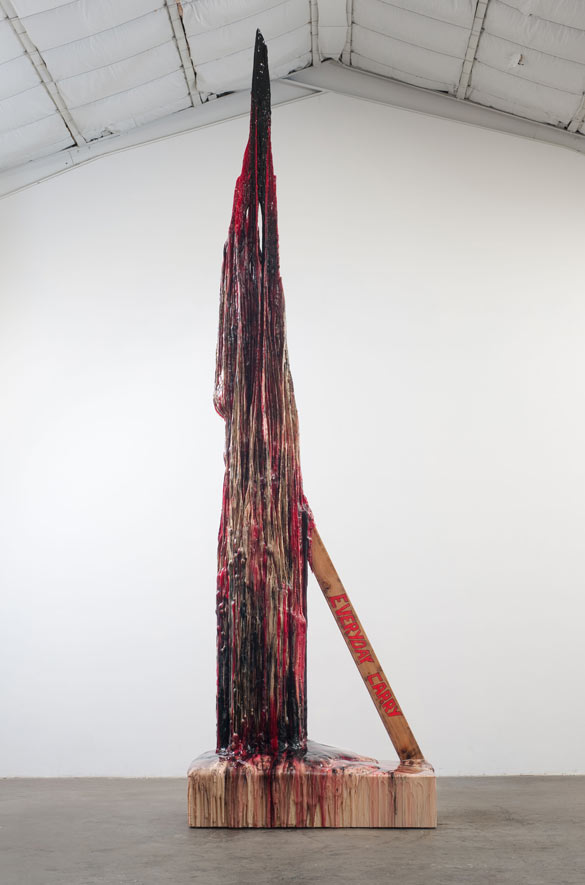Sterling Ruby

An expression of repressed violence
Souvent considéré – à tort – comme un artiste provocateur, adepte du Big is beautiful, Sterling Ruby est en réalité bien plus que cela. Si son esthétique est pour le moins éloignée du Less is more, pour reprendre une autre formule célèbre, il serait réducteur de ne voir en lui qu’un autre parangon de la désormais fameuse scène West Coast, rompu au spectaculaire au détriment du discours. Le corpus qu’il développe depuis une quinzaine d’années, sous des atours parfois un peu trashy, permet d’envisager une lecture de la société américaine extrêmement critique et lucide, tout en se jouant des nombreuses filiations aux grands mouvements artistiques de la seconde moitié du vingtième siècle que les journalistes et critiques formulent régulièrement à son encontre. En effet, au fil des articles qui lui sont consacrés reviennent sans cesse les références au minimalisme – et notamment à Donald Judd – ou à l’Anti-Form théorisé par Robert Morris en 1968. Un réseau d’influences que Sterling Ruby ne renie pas, bien au contraire. Néanmoins, loin de rester dans la simple convocation ou citation, lorsqu’il s’empare de ces courants emblématiques, c’est pour mieux les altérer et les pervertir. En recouvrant de salissures ou de graffitis un bloc monolithique qui rappelle immanquablement les formes de l’art minimal, il en perturbe la lecture et le place non plus sur le seul terrain de l’esthétique et du champ de l’art proprement dit, mais le confronte à la rue, le fragilise et lui confère un autre statut. Ce faisant, il détourne l’attention du spectateur de l’objet et de la forme pure pour orienter son regard vers la violence et la perversité de son intervention. Ainsi de la série des SP, peintures grand format qui rappellent le Color Field Painting cher à Mark Rothko. Mais là où ce dernier travaillait à l’huile, à l’acrylique ou à l’aquarelle, Sterling Ruby réalise ses peintures à la bombe aérosol, utilisant une palette de couleurs allant du noir profond au vert fluo. Par ailleurs, loin de l’apaisement provoqué par les œuvres du célèbre peintre d’origine russe, Sterling Ruby puise son inspiration dans les nombreuses inscriptions réalisées à la bombe aérosol par les gangs dans les rues de Los Angeles pour marquer leur territoire, dans une accumulation de signes qui finit par virer à l’abstraction. Quant à l’installation vidéo The Masturbators (2009), elle montre neuf pornstars en train de se masturber face caméra. Rejouant avec beaucoup d’ironie la figure de l’artiste performant seul dans son studio, à la manière de Bruce Nauman ou de Paul McCarthy, Sterling Ruby pose ici un regard pour le moins décalé sur l’industrie pornographique florissante en Californie, en soulignant la vacuité de l’action de ses acteurs, tout autant que les codes de la masculinité qu’impose notre société – des corps bodybuildés aux râles forcés des différents protagonistes.

Sterling Ruby SP202 (1 to 4), 2012. Peinture aérosol sur toile / Spray paint on canvas, 406.4 × 596.9 × 5.1 cm. Photo : Robert Wedemeyer, Los Angeles. Courtesy the artist and Xavier Hufkens, Brussels.
Résident de la cité des anges depuis quelques années, Sterling Ruby est aux premières loges pour observer les dérives de la société américaine dont la Californie est un miroir grossissant. Il s’empare d’ailleurs des codes de cette implacable société du spectacle pour en dénoncer les nombreux travers. Ainsi de l’exposition « SUPERMAX », présentée en 2008 au Museum of Contemporary Art de Los Angeles, qui plongeait le visiteur dans une oppressante ambiance post-apocalyptique. Cette installation totale, particulièrement impressionnante, se voulait une virulente critique de Supermax, un programme gouvernemental très controversé qui se concentre sur la détention et l’isolement des prisonniers, à raison de 23h par jour. En mettant ainsi en parallèle l’architecture du Pacific Design Center avec Pelican Bay, prison de haute sécurité de Californie du Nord, Sterling Ruby souhaitait dénoncer les dérives du système pénitentiaire américain, devenu extrêmement répressif depuis les attentats du 11 septembre 2001, les restrictions des libertés individuelles, tout comme la paranoïa de la population américaine – ou tout au moins de ses gouvernants – face au terrorisme et à la délinquance.

Sterling Ruby Vues de l’exposition Soft Work au FRAC Champagne-Ardenne, 2012. Photo : Martin Argyroglo.
Le dernier corpus en date de Sterling Ruby, intitulé SOFT WORK, a notamment été présenté au FRAC Champagne-Ardenne il y a quelques mois. Cet ensemble se compose d’une multitude de formes molles, réalisées à partir de morceaux de tissus colorés récupérés ça et là, dont la facture rappelle les quilts réalisés par les Amish ou le Boro japonais. Alors que ses œuvres précédentes se dressaient fièrement et portaient en elles une forme de défi et d’arrogance, les travaux réunis ici traînent au sol ou pendouillent, inertes, comme si l’artiste était passé d’une forme active et volontaire de protestation à une sorte de désillusion ou de renoncement. A priori plus ludique que ses précédents travaux, du fait des couleurs vives et de l’aspect rassurant de ces figures molles, l’installation n’en est que plus retorse. En effet, ancien assistant de Mike Kelley au Art Center College of Design de Pasadena, Sterling Ruby est depuis longtemps familier des thèses défendues par son « mentor », et donc très conscient de la charge émotionnelle contenue dans ces pièces de tissu ou dans les Husbands, gros coussins en vogue dans les années quatre-vingt dans lesquels se lovaient les femmes célibataires américaines, présentés ici tels des rebuts, délaissés et abandonnés.
Avec SOFT WORK, Sterling Ruby s’intéresse donc à l’espace privé, habituel lieu de repli et de protection. Toutefois, point de salut au sein de la famille américaine selon le trublion californien, la sphère de l’intime devenant chez lui non plus le refuge contre l’extérieur, mais bien le lieu de l’aliénation – notamment de la femme – et de l’enfermement. Là où la célèbre peinture de Jasper Johns représentant le drapeau américain trônait fièrement, tel un étendard, le flag de Sterling Ruby pend du plafond, comme en berne, annonçant le délitement de la cellule familiale traditionnelle et l’angoisse à laquelle doivent faire face de nombreux citoyens américains face à la situation actuelle. Une installation d’une rare violence qui, sous des atours séduisants, dresse au final un constat implacable de l’état de la société américaine, et plus globalement de la situation mondiale.
An expression of repressed violence, Sterling Ruby
Sterling Ruby is often – and wrongly – regarded as a provocative artist and an advocate of Big is beautiful. In reality, however, he is much more than this. His aesthetic is, to say the least, well removed from Less is more – to borrow another celebrated slogan – but it would be simplistic to see in him just another paragon of the now famous West Coast scene, well-versed in the spectacular to the detriment of discourse. The body of work that he has been developing for the past fifteen years or so, at times bedecked in a slightly trashy way, enables us to see an extremely critical and lucid interpretation of American society, while at the same time paying no heed to the many links with the great art movements of the latter half of the 20th century that journalists and critics regularly refer to in his regard. The fact is that in articles devoted to him, there are recurrent references to Minimalism – and to Donald Judd in particular – and to the Anti-Form given theoretical treatment by Robert Morris in 1968. There is indeed a network of influences which Sterling Ruby does not deny—quite to the contrary. Nevertheless, far from remaining in mere summoning and citation, when he appropriates these emblematic tendencies, it is the better to alter and warp them. By covering a monolithic block with dirt and graffiti, which inevitably calls the forms of Minimal Art to mind, he upsets our reading of it, and puts it no longer just in the terrain of aesthetics and the field of art properly so-called, but confronts it with the street, renders it fragile, and lends it another status. In so doing, he diverts the spectator’s attention from the object and the pure form, and directs his eye towards the violence and perverseness of his intervention. So it is with the SP series, large-format paintings which call to mind the Color Field Painting dear to Mark Rothko. But precisely where this latter worked in oil, acrylic and watercolour, Sterling Ruby makes his paintings with aerosol sprays, using a palette of colours ranging from deep black to dayglo green. Furthermore, far from the soothing quality caused by the famous painter of Russian origin, Sterling Ruby draws his inspiration from the numerous inscriptions made with aerosol sprays by the street gangs of Los Angeles to mark their turf, in an accumulation of signs which ends up by veering towards abstraction. As for the video installation The Masturbators (2009), it shows nine porn stars masturbating in front of the camera. Re-enacting, with a great deal of irony, the figure of the artist performing alone in his studio, in the manner of Bruce Nauman and Paul McCarthy, Sterling Ruby here casts a nothing if not offbeat eye on the thriving pornography industry in California, emphasizing the vacuousness of the action of its actors, just as much as the codes of masculinity imposed by our society–worked-out bodies with the forced rattles of the different protagonists.

Sterling Ruby Basin Theology/CHC 3, 2012. Céramique / ceramic, 26 × 87 × 83.8 cm. Photo : Robert Wedemeyer, Los Angeles. Courtesy the Artist and Xavier Hufkens, Brussels.
Sterling Ruby has lived in the City of Angels for some years, and has a ringside seat when it comes to looking at the aberrations of American society, which California is a magnifying mirror of. What is more, he appropriates the codes of this relentless society of the spectacle, and rails against its many shortcomings. So it was with the exhibition “Supermax”, held in 2008 at the Museum of Contemporary Art in Los Angeles, which plunged visitors into an oppressive post-apocalyptic atmosphere. This total and especially impressive installation was intended as a virulent criticism of Supermax, a highly controversial government programme entailing the detention and isolation of prisoners in their cells for 23 hours a day. By thus connecting the architecture of the Pacific Design Center with Pelican Bay, a maximum security prison in northern California, Sterling Ruby wanted to speak out against the aberrations of the American prison system – which has become extremely repressive since the 9/11 attacks – restrictions on civil liberties, and the paranoia among the American people – or at least among its rulers – in the face of terrorism and crime.

Sterling Ruby Monument Stalagmite/Everyday Carry, 2012. Tube de PVC, mousse, bois, peinture aérosol et formica / PVC pipe, foam, urethane, wood, spray paint and formica, 541 × 101.6 × 160 cm. Photo : Robert Wedemeyer, Los Angeles. Courtesy the artist and Xavier Hufkens, Brussels.
The last body of work produced to date by Sterling Ruby, titled Soft Work, was shown in particular at the FRAC Champagne-Ardenne a few months back. This ensemble is made up of a host of soft forms, made using bits of coloured fabric retrieved here and there, their style reminiscent of the quilts made by the Amish in the United States and the Boro in Japan. While his previous works stood proud and carried within them a form of defiance and arrogance, the pieces brought together here drag on the floor, or dangle, inert, as if the artist had shifted from an active and deliberate form of protest to a kind of disillusionment and renunciation. The installation, which, on the face of it, is more playful than his earlier works, because of the bright colours and the comforting look of these soft figures, is nothing if not craftier. In fact, as a former assistant to Mike Kelley at the Art Center College of Design in Pasadena, Sterling Ruby has long been familiar with the theses championed by his “mentor”, and is accordingly very aware of the emotional charge contained in these pieces of fabric, and in the Husbands, large cushions which were much in vogue in the 1980s, in which single American women curled up, here presented as rejects, discarded and abandoned.
With Soft Work, Sterling Ruby is thus interested in the private space, the usual place of withdrawal and protection. But a place of salvation, nonetheless, in the bosom, of the American family, according to the Californian troublemaker, the sphere of privacy becoming in his work no longer a refuge against the outside world, but rather a place of alienation—especially of women—and confinement. Precisely where Jasper Johns’s famous picture depicting the American flag had pride of place, like a standard, Sterling Ruby’s flag hangs from the ceiling, as if at half mast, announcing the crumbling of the traditional family cell and the anxiety which many American citizens are having to cope with in the face of the present-day situation. An installation of a rare violence which, seductively attired, in the end makes an inexorable statement about the state of American society, and more broadly about the worldwide situation.
- Partage : ,
- Du même auteur : Leonor Antunes, Laëtitia Badaut Haussmann, Walid Raad, Inside Information, Rossella Biscotti, History Repeating, Rosa Barba : Universal Cinema,
articles liés
Iván Argote
par Patrice Joly
Laurent Proux
par Guillaume Lasserre
Diego Bianchi
par Vanessa Morisset

